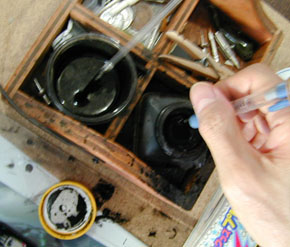Takeshi Oshima’s home in west Tokyo seems very ordinary: His wife opens the door with a warm greeting, and soon after his son appears, tugging on her apron. But things change on the stairs that lead to the basement.
Large stacks of dusty manga comic books are on the edge of each step. Upon reaching the basement, more multi-colored volumes can be seen running half-way to the ceiling. A cluttered desk holds five mugs of pens and an inkwell. Just below are a drawing board and color pictures of bikini-clad young girls beneath heavy see-through plastic shields. These ladies are used as drawing guides for Oshima, who is a manga artist specializing in adult comics.
Oshima does not consider his comics to be pure hentai manga, whose focus is on the molestation of women through the use of elongated tongues, tentacles, or other long, thin probes. Though he has dabbled in the hentai genre, his 25-year career has mainly featured women simply enjoying sex.
His “Kanji Sasete Baby” series from 15 years ago was his breakthrough. It appeared in Young Magazinewith a translation into Italian appearing 10 years later. Today, Bazooka, Shuman Special, Geino Nippon, and the women’s monthly Amour regularly feature his comics.
Like most artists, Oshima has a trademark easily identifiable by his devotees: women with extremely large, round breasts. To be more specific, Oshima’s rendering of the female mammary carriage takes the form of a pair of gravity-defying Christmas tree bulbs on steroids.
His start in the business was not conventional. While he was enrolled at Tokyo’s prestigious Waseda University as a business student, Oshima was coaxed by hentai manga legend Toshio Maeda to drop his textbooks in favor of an ink pen. He’s been drawing balloon-breasted females in various compromising positions of ecstasy ever since. “I ruined his life,” Maeda jokes about his influence on Oshima’s move from business to busts.
Interview
Captain Japan: For a Western reader, your sort of manga might be seen as surprising, maybe sort of shocking, especially considering that some of your work is directed at women. It sort of goes against traditional Japanese stereotypes. What do you think about that?
 Takeshi Oshima: Recently, a French journalist wrote an article wondering why Japanese ladies are reading this type of trash. He wondered, are Japanese ladies sluts? I do feel strange that some women like rape and molestation stories. But, you know, I believe this sort of magazine is a way to unleash their carnal desires.
Takeshi Oshima: Recently, a French journalist wrote an article wondering why Japanese ladies are reading this type of trash. He wondered, are Japanese ladies sluts? I do feel strange that some women like rape and molestation stories. But, you know, I believe this sort of magazine is a way to unleash their carnal desires.CJ: A few years ago, a journalist from the New York Times, Nicholas Kristof, touched upon some similar themes in his articles. He received a lot of pressure from the Japanese community in the U.S. because they felt his portrayal of Japanese women was not quite accurate. Do you think Japanese women are really demure and conservative, as the stereotype goes?
TO: Yes, that’s true. But, you know, you have several feelings inside of you. Sometimes you are innocent; sometimes you are indecent – it is part of being a human being.
(He holds up a copy of Amour – Captain.) This magazine sort of puts a light on the dark side of these ladies because even a sophisticated lady likes to be a slut in certain situations. But I must emphasize that these types of magazines are read by regular office ladies – they are single and lonely. You know, about 15 years ago this magazine wouldn’t have been possible. It shows that women’s interests have been changing.
CJ: When I spoke with Toshio Maeda, he said that he was reading scripts for television shows and movies directed at women to understand their feelings. What do you do?
TO: I access the internet and chat with women. The girls are always amazed with my technique for hitting on them. I can understand their fantasy completely. I sort of have a special way of whispering to them through typing. It is only typing, but don’t tell my wife! (laughs) In fact, this morning I did it. It is sort of like fishing.
He moves over to his computer monitor to the left of his drawing board where he brings up a dialogue which has a log of a conversation with a married 31-year-old whose husband is sleeping. He asks what she wants and she responds. The statements are brief and to the point – the neck is kissed, nipples are touched, the hair is stroked – and culminate with her exclamations of cyber, or maybe real, ecstasy.
 CJ: I am a little interested in your family. When we were upstairs I saw your wife and son. Are you worried about the influence your work might have on your son?
CJ: I am a little interested in your family. When we were upstairs I saw your wife and son. Are you worried about the influence your work might have on your son?TO: Right now he is in junior high school. So far he hasn’t seen any of my work. But, you know, when he gets older, it will be okay for him to see what I am doing. It is nothing harmful, and at around the age of 14 or 15, it might be acceptable for him.
CJ: And your wife?
TO: She doesn’t care at all. Before we were married she knew what I was doing. In Japan, work has nothing to do with one’s personality. Work is work. Work is the way you feed your family. The bottom line is how much money you make.
CJ: Do you have fans writing to you with their reactions to your work?
TO: (Again, he holds up a copy of Amour – Captain.) In this magazine, there is a survey section and I am able to read some of the responses. Girls write in and confess their fantasy.
After digging through his files, he finds one example from a 31-year old office lady: “I would like to see lesbian comics. Please teach me the appropriate techniques. I really admire these stories because it could never happen with me. But I hope it could one day.”
CJ: Why did you choose adult comics instead of kids’ comics?
TO: It is more difficult to make stories for kids – you must maintain a level of popularity. If you fail, you’ll be fired quickly. It is a severe situation with the competition because new artists are always entering the field.
Adult comics are easier – there is no hard competition. For kids’ magazines, you have to be edgy. The feeling, how do I say, you have to know what’s in, what’s out – the trends of the day.
CJ: How is business these days versus, say, 10 years ago? Is it tough to get these writing jobs?
TO: Very…tough. And it is energy-consuming work. It might take 3 or 4 days to draw one comic. But after that, you are exhausted completely.
 And business is getting worse – it’s the recession. Before the salaryman could buy at least a couple of books each week. But now, maybe just one. And discount shops and manga kissa (A store where one pays to read comics for an hourly rate – Captain.) are taking away sales. It’s tough all around.
And business is getting worse – it’s the recession. Before the salaryman could buy at least a couple of books each week. But now, maybe just one. And discount shops and manga kissa (A store where one pays to read comics for an hourly rate – Captain.) are taking away sales. It’s tough all around.CJ: I asked Toshio Maeda about his influences and he said he was heavily influenced by American comics when he was young. How about you?
TO: Well, very old Japanese cartoonists influenced me. Maybe a little bit by Tezuka Osamu and “Mighty Atom,” but I really liked Shirato Sanpei and his ninja stories. He was a legend. It wasn’t just a funny story; he also included communist themes, as he was a known communist, with stories about one such character, Sasuke, who was struggling to survive in a particular society.
Also, when I was in elementary school, I was very heavily influenced by Akatsuka Fujio – the gag manga genius. In Japan, you can find cynical or sarcastic stories in gag manga. It is really totally different from simple gags seen in Western comedy. Reading between the lines in gag manga is very funny. It is nothing like “The Three Stooges.”
Note: All drawing images provided by Takeshi Oshima. This article originally appeared in January 2003 on the Sake-Drenched Postcards Web page.






